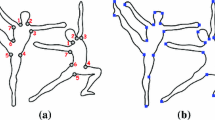Abstract
This paper presents a new geometric deformation method based on 3D volume morphing by using a new concept called directional polar coordinate. The user specifies the source control object and the destination control object which act as the embedded spaces. The source and the destination control objects determine a 3D volume morphing which maps the space enclosed in the source control object to that of the destination control object. By embedding the object to be deformed into the source control object, the 3D volume morphing determines the deformed object automatically without the tiring moving of control points. Experiments show that this deformation model is efficient and intuitive, and it can achieve some deformation effects which are difficult to achieve for traditional methods.
Similar content being viewed by others
References
Barr A H. Global and local deformations of solid primitives.Computer Graphics, 1984, 18(3): 21–30.
Sederberg T W, Parry S R. Free-form deformation of solid geometric models.Computer Graphics, 1986, 20(4): 151–160.
Coquillart S. Extended free-form deformation: A sculpturing tool for 3D geometric modeling.Computer Graphics, 1990, 24(4): 187–196.
MacCracken R, Joy K I. Free-form deformations with lattices of arbitrary topology.Computer Graphics, 1996, 26(4): 181–188.
Decaudin P. Geometric deformation by merging a 3D-object with a simple shape. InGraphics Interface’96, May, 1996, pp. 55–60.
Lazarus F, Coquillart S, Jancene P. Axial deformations: An intuitive deformation technique.Computer Aided Design, 1994, 26(8): 607–613.
Peng Qunsheng, Jin Xiaogang, Feng Jieqing. Arc-length-based axial deformation and length preserving deformation. InComputer Animation’97, Geneva, IEEE Computer Society, 1997, pp. 86–92.
Singh K, Fiume E. Wires: A geometric deformation technique.Computer Graphics, 1998, 30(3): 405–414.
Hsu W, Hughes J, Kaufmann H. Direct manipulations of free-form deformations.Computer Graphics, 1992, 26(2): 177–184.
Borrel P, Rappoport A. Simple constrained deformations for geometric modeling and interactive design.ACM Transactions on Graphics, 1994, 13(2): 137–155.
Bao Hujun, Jin Xiaogang, Peng Qunsheng. Constrained deformations based on metaballs.Chinese Journal of Advanced Software Research, 1999, 6(3): 211–217.
Jin Xiaogang, Li Y F, Peng Qunsheng. General constrained deformations based on generalized metaballs.Computers & Graphics, 2000, 24(2): 219–231.
Kent J R, Carlson W E, Parent R E. Shape transformation for polyhedral objects.Computer Graphics, 1992, 26(2): 47–54.
Lerios A, Garfinkle C D, Levoy M. Feature-based volume metamorphosis.Computer Graphics, 1995, 29(3): 449–456.
Cohen-Or D, Levin D, Solomovici A. Three-dimensional distance field metamorphosis.ACM Transactions of Graphics, 1988, 17(2): 116–141.
Hanrahan P. A Survey of Ray-Surface Intersection Algorithms. InAn Introduction to Ray Tracing, Glassner A S (ed.), Academic Press Limited, 1989, pp. 79–119.
Arvo J, Kirk D. A Survey of Ray Tracing Acceleration Techniques. InAn Introduction to Ray Tracing, Glassner A S (ed.), Academic Press Limited, 1989, pp. 201–262.
Haines E A, Greenberg D P. The light buffer: A ray tracer shadow testing accelerator.IEEE Computer Graphics & Application, 1986, 6(9): 6–16.
Badouel D. An Efficient Ray-Polygon Intersection. InGraphics Gems, Glassner A S (ed.), Boston: Academic Press Inc., 1990, pp. 390–393.
Moler T, Trumbore B, Fast, minimum storage ray-triangle intersection.Journal of Graphics Tools, 1997, 2(1): 21–28.
Author information
Authors and Affiliations
Corresponding author
Additional information
This work is supported by the National Natural Science Foundation of China (No. 69973040) and Zhejiang Provincial Natural Science Foundation (No. 698022)
JIN Xiaogang received his Ph.D. degree in computational geometry and computer graphics from Zhejiang University in 1995. He is currently a professor of the State Key Lab of CAD&CG at Zhejiang University. His research interests include computer animation, implicit surface modeling and animation, realistic image synthesis.
WAN Huagen received his Ph.D. degree in computational geometry and computer graphics from Zhejiang University in 1999. He is currently an associate professor of the State Key Lab of CAD&CG at Zhejiang University. His main research interests include solid modeling in virtual environment and computer animation.
PENG Qunsheng was born in 1947. He received his Ph.D. degree from School of Computing Studies, University of East Anglia, U.K. in 1983. He is currently a professor and the Director of State Key Laboratory of CAD&CG. His research interests include realistic image synthesis, virtual reality, scientific data visualization etc.
Rights and permissions
About this article
Cite this article
Jin, X., Wan, H. & Peng, Q. Geometric deformations based on 3D volume morphing. J. Comput. Sci. & Technol. 16, 443–449 (2001). https://doi.org/10.1007/BF02948962
Received:
Revised:
Issue Date:
DOI: https://doi.org/10.1007/BF02948962




